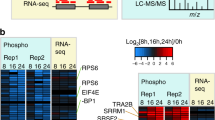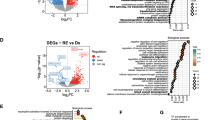Abstract
Mutations in genes encoding splicing factors (which we refer to as spliceosomal genes) are commonly found in patients with myelodysplastic syndromes (MDS) and acute myeloid leukemia (AML)1,2,3. These mutations recurrently affect specific amino acid residues, leading to perturbed normal splice site and exon recognition4,5,6. Spliceosomal gene mutations are always heterozygous and rarely occur together with one another, suggesting that cells may tolerate only a partial deviation from normal splicing activity. To test this hypothesis, we engineered mice to express a mutated allele of serine/arginine-rich splicing factor 2 (Srsf2P95H)—which commonly occurs in individuals with MDS and AML—in an inducible, hemizygous manner in hematopoietic cells. These mice rapidly succumbed to fatal bone marrow failure, demonstrating that Srsf2-mutated cells depend on the wild-type Srsf2 allele for survival. In the context of leukemia, treatment with the spliceosome inhibitor E7107 (refs. 7,8) resulted in substantial reductions in leukemic burden, specifically in isogenic mouse leukemias and patient-derived xenograft AMLs carrying spliceosomal mutations. Whereas E7107 treatment of mice resulted in widespread intron retention and cassette exon skipping in leukemic cells regardless of Srsf2 genotype, the magnitude of splicing inhibition following E7107 treatment was greater in Srsf2-mutated than in Srsf2-wild-type leukemia, consistent with the differential effect of E7107 on survival. Collectively, these data provide genetic and pharmacologic evidence that leukemias with spliceosomal gene mutations are preferentially susceptible to additional splicing perturbations in vivo as compared to leukemias without such mutations. Modulation of spliceosome function may thus provide a new therapeutic avenue in genetically defined subsets of individuals with MDS or AML.
This is a preview of subscription content, access via your institution
Access options
Subscribe to this journal
Receive 12 print issues and online access
$209.00 per year
only $17.42 per issue
Buy this article
- Purchase on Springer Link
- Instant access to full article PDF
Prices may be subject to local taxes which are calculated during checkout




Similar content being viewed by others
Change history
11 May 2016
In the version of this article initially published online, the graphs in Figure 3b–d were laid out incorrectly and were not consistent with the figure legend and text. The error has been corrected for the print, PDF and HTML versions of this article.
References
Yoshida, K. et al. Frequent pathway mutations of splicing machinery in myelodysplasia. Nature 478, 64–69 (2011).
Papaemmanuil, E. et al. Somatic SF3B1 mutation in myelodysplasia with ring sideroblasts. N. Engl. J. Med. 365, 1384–1395 (2011).
Graubert, T.A. et al. Recurrent mutations in the U2AF1 splicing factor in myelodysplastic syndromes. Nat. Genet. 44, 53–57 (2012).
Shirai, C.L. et al. Mutant U2AF1 expression alters hematopoiesis and pre-mRNA splicing in vivo. Cancer Cell 27, 631–643 (2015).
Kim, E. et al. SRSF2 mutations contribute to myelodysplasia by mutant-specific effects on exon recognition. Cancer Cell 27, 617–630 (2015).
Ilagan, J.O. et al. U2AF1 mutations alter splice site recognition in hematological malignancies. Genome Res. 25, 14–26 (2015).
Folco, E.G., Coil, K.E. & Reed, R. The antitumor drug E7107 reveals an essential role for SF3b in remodeling U2 snRNP to expose the branch point-binding region. Genes Dev. 25, 440–444 (2011).
Kotake, Y. et al. Splicing factor SF3b as a target of the antitumor natural product pladienolide. Nat. Chem. Biol. 3, 570–575 (2007).
Lindsley, R.C. et al. Acute myeloid leukemia ontogeny is defined by distinct somatic mutations. Blood 125, 1367–1376 (2015).
Genovese, G., Jaiswal, S., Ebert, B.L. & McCarroll, S.A. Clonal hematopoiesis and blood-cancer risk. N. Engl. J. Med. 372, 1071–1072 (2015).
Xie, M. et al. Age-related mutations associated with clonal hematopoietic expansion and malignancies. Nat. Med. 20, 1472–1478 (2014).
Genovese, G. et al. Clonal hematopoiesis and blood-cancer risk inferred from blood DNA sequence. N. Engl. J. Med. 371, 2477–2487 (2014).
Katz, Y., Wang, E.T., Airoldi, E.M. & Burge, C.B. Analysis and design of RNA sequencing experiments for identifying isoform regulation. Nat. Methods 7, 1009–1015 (2010).
Wagenmakers, E.J., Lodewyckx, T., Kuriyal, H. & Grasman, R. Bayesian hypothesis testing for psychologists: a tutorial on the Savage–Dickey method. Cognit. Psychol. 60, 158–189 (2010).
Zhang, J. et al. Disease-associated mutation in SRSF2 misregulates splicing by altering RNA-binding affinities. Proc. Natl. Acad. Sci. USA 112, E4726–E4734 (2015).
Lavallée, V.P. et al. The transcriptomic landscape and directed chemical interrogation of MLL-rearranged acute myeloid leukemias. Nat. Genet. 47, 1030–1037 (2015).
Daigle, S.R. et al. Selective killing of mixed lineage leukemia cells by a potent small-molecule DOT1L inhibitor. Cancer Cell 20, 53–65 (2011).
Bernt, K.M. et al. MLL-rearranged leukemia is dependent on aberrant H3K79 methylation by DOT1L. Cancer Cell 20, 66–78 (2011).
Yokoi, A. et al. Biological validation that SF3b is a target of the antitumor macrolide pladienolide. FEBS J. 278, 4870–4880 (2011).
Papaemmanuil, E. et al. Clinical and biological implications of driver mutations in myelodysplastic syndromes. Blood 122, 3616–3627, quiz 3699 (2013).
Bejar, R. et al. Validation of a prognostic model and the impact of mutations in patients with lower-risk myelodysplastic syndromes. J. Clin. Oncol. 30, 3376–3382 (2012).
Zhang, S.J. et al. Genetic analysis of patients with leukemic transformation of myeloproliferative neoplasms shows recurrent SRSF2 mutations that are associated with adverse outcome. Blood 119, 4480–4485 (2012).
Vannucchi, A.M. et al. Mutations and prognosis in primary myelofibrosis. Leukemia 27, 1861–1869 (2013).
Effenberger, K.A., Urabe, V.K., Prichard, B.E., Ghosh, A.K. & Jurica, M.S. Interchangeable SF3B1 inhibitors interfere with pre-mRNA splicing at multiple stages. RNA 22, 350–359 (2016).
Bonnal, S., Vigevani, L. & Valcárcel, J. The spliceosome as a target of novel antitumor drugs. Nat. Rev. Drug Discov. 11, 847–859 (2012).
Eskens, F.A. et al. Phase 1 pharmacokinetic and pharmacodynamic study of the first-in-class spliceosome inhibitor E7107 in patients with advanced solid tumors. Clin. Cancer Res. 19, 6296–6304 (2013).
Hong, D.S. et al. A phase 1, open-label, single-arm, dose-escalation study of E7107, a precursor messenger ribonucleic acid (pre-mRNA) splicesome inhibitor, administered intravenously on days 1 and 8 every 21 days to patients with solid tumors. Invest. New Drugs 32, 436–444 (2014).
Katz, Y. et al. Quantitative visualization of alternative exon expression from RNA-seq data. Bioinformatics 31, 2400–2402 (2015).
Thorvaldsdóttir, H., Robinson, J.T. & Mesirov, J.P. Integrative genomics viewer (IGV): high-performance genomics data visualization and exploration. Brief. Bioinform. 14, 178–192 (2013).
National Research Council. Guide for the Care and Use of Laboratory Animals 8th edn. (The National Academies Press, 2011).
Wang, H.Y., Xu, X., Ding, J.H., Bermingham, J.R. Jr. & Fu, X.D. SC35 plays a role in T cell development and alternative splicing of CD45. Mol. Cell 7, 331–342 (2001).
Georgiades, P. et al. Vav-Cre transgenic mice: a tool for mutagenesis in hematopoietic and endothelial lineages. Genesis 34, 251–256 (2002).
Cheng, D.T. et al. Memorial Sloan Kettering–integrated mutation profiling of actionable cancer targets (MSK-IMPACT): a hybridization-capture-based next-generation sequencing clinical assay for solid tumor molecular oncology. J. Mol. Diagn. 17, 251–264 (2015).
Meyer, L.R. et al. The UCSC Genome Browser database: extensions and updates 2013. Nucleic Acids Res. 41, D64–D69 (2013).
Flicek, P. et al. Ensembl 2013. Nucleic Acids Res. 41, D48–D55 (2013).
Hubert, C.G. et al. Genome-wide RNAi screens in human brain tumor isolates reveal a novel viability requirement for PHF5A. Genes Dev. 27, 1032–1045 (2013).
Langmead, B., Trapnell, C., Pop, M. & Salzberg, S.L. Ultrafast and memory-efficient alignment of short DNA sequences to the human genome. Genome Biol. 10, R25 (2009).
Li, B. & Dewey, C.N. RSEM: accurate transcript quantification from RNA-seq data with or without a reference genome. BMC Bioinformatics 12, 323 (2011).
Kim, D. et al. TopHat2: accurate alignment of transcriptomes in the presence of insertions, deletions and gene fusions. Genome Biol. 14, R36 (2013).
Trapnell, C., Pachter, L. & Salzberg, S.L. TopHat: discovering splice junctions with RNA-seq. Bioinformatics 25, 1105–1111 (2009).
Robinson, M.D. & Oshlack, A. A scaling normalization method for differential expression analysis of RNA-seq data. Genome Biol. 11, R25 (2010).
Young, M.D., Wakefield, M.J., Smyth, G.K. & Oshlack, A. Gene ontology analysis for RNA-seq: accounting for selection bias. Genome Biol. 11, R14 (2010).
Guberman, J.M. et al. BioMart central portal: an open database network for the biological community. Database 2011, bar041 (2011).
Acknowledgements
This work was supported by the Leukemia and Lymphoma Society (S.C.-W.L. and O.A.-W.), the US Department of Defense Breast Cancer Research Program grant W81XWH-14-1-0044 (H.D.), the US Department of Defense Bone Marrow Failure Research Program grants BM150092 (O.A.-W.) and W81XWH-12-1-0041 (R.K.B. and O.A.-W.), the Worldwide Cancer Research Fund (E.K.), the Fondation de France (J.-B.M.), the American Society of Hematology (B.H.D. and O.A.-W.), the Edward P. Evans Foundation (R.K.B. and O.A.-W.), the US National Institutes of Health (NIH)-NHLBI grant R01 HL128239 (R.K.B. and O.A.-W.), the NIH–NCI grant 1K08CA160647-01 (O.A.-W.), the Ellison Medical Foundation grant AG-NS-1030-13 (R.K.B.), the Damon Runyon Foundation (R.K.B. and O.A.-W.), the NIH–NIDDK grant R01 DK103854 (R.K.B.), the Starr Foundation grant I8-A8-075 (O.A.-W.), the Josie Robertson Investigator Program (O.A.-W.), the Mr. William H. Goodwin and Mrs. Alice Goodwin Commonwealth Foundation for Cancer Research (O.A.-W.), and the Experimental Therapeutics Center of MSKCC (O.A.-W.).
Author information
Authors and Affiliations
Contributions
S.C.-W.L., H.D., E.K., R.K.B., and O.A.-W. designed the study; S.C.-W.L., E.K., H.C., Y.R.C., J.-B.M., B.H.D., A.Y., Y.J.K., C.-W.C., A.P., J.T., X.W., A.K., S.A.A., and O.A.-W. performed experiments; H.D. and R.K.B. performed RNA-seq analysis; M.T., J.P., S.B., and P.G.S. provided E7107 and advice with drug-dosing experiments; and S.C.-W.L., H.D., E.K., C.L., R.K.B., and O.A.-W. prepared the manuscript with help from all co-authors.
Corresponding authors
Ethics declarations
Competing interests
M.T., J.P., S.B., and P.G.S. are employees of H3 Biomedicine, Inc.
Supplementary information
Supplementary Text and Figures
Supplementary Figures 1–6 and Supplementary Tables 2 and 4 (PDF 40706 kb)
Supplementary Table 1
Median normalized gene expression values across replicates in each of the murine mRNA sequencing experiments shown in Figures 1-3. (XLSX 2160 kb)
Supplementary Table 3
Median exon inclusion rates (PSI (percent spliced in) values (ψ)) for cassette exons across replicates in each of the murine mRNA sequencing experiments shown in Figures 1-3. (XLSX 1831 kb)
Rights and permissions
About this article
Cite this article
Lee, SW., Dvinge, H., Kim, E. et al. Modulation of splicing catalysis for therapeutic targeting of leukemia with mutations in genes encoding spliceosomal proteins. Nat Med 22, 672–678 (2016). https://doi.org/10.1038/nm.4097
Received:
Accepted:
Published:
Issue Date:
DOI: https://doi.org/10.1038/nm.4097
This article is cited by
-
E7820, an anti-cancer sulfonamide, degrades RBM39 in patients with splicing factor mutant myeloid malignancies: a phase II clinical trial
Leukemia (2023)
-
SRSF2 mutation reduces polycythemia and impairs hematopoietic progenitor functions in JAK2V617F-driven myeloproliferative neoplasm
Blood Cancer Journal (2023)
-
What role for somatic mutations in systemic inflammatory and autoimmune diseases associated with myelodysplastic neoplasms and chronic myelomonocytic leukemias?
Leukemia (2023)
-
Biological drivers of clinical phenotype in myelofibrosis
Leukemia (2023)
-
Therapeutic Targets in Myelodysplastic Neoplasms: Beyond Hypomethylating Agents
Current Hematologic Malignancy Reports (2023)



